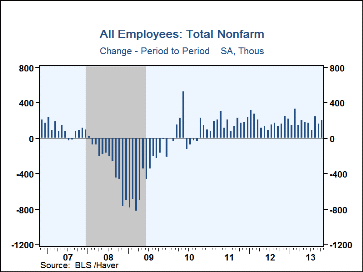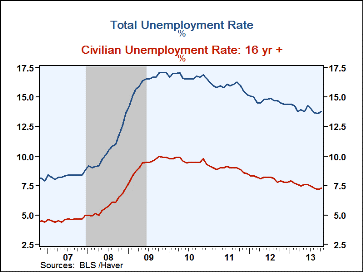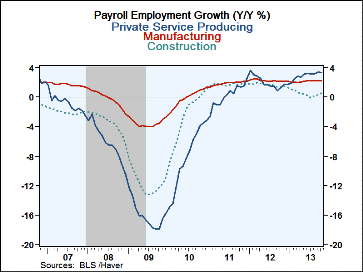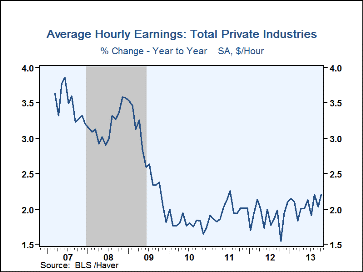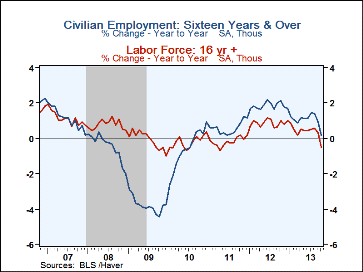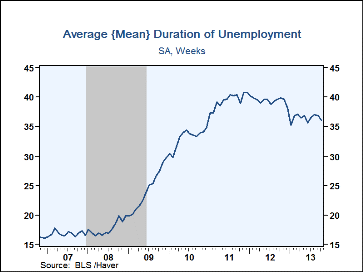 Global| Nov 08 2013
Global| Nov 08 2013U.S. Payroll Job Gain Is Unexpectedly Strong; Jobless Rate Notches Up
by:Tom Moeller
|in:Economy in Brief
Summary
The job market posted surprising growth last month. Nonfarm payrolls increased 204,000 (1.7% y/y) during October following upwardly revised gains of 163,000 and 238,000 during the prior two months. A 122,000 gain had been expected [...]
The job market posted surprising growth last month. Nonfarm payrolls increased 204,000 (1.7% y/y) during October following upwardly revised gains of 163,000 and 238,000 during the prior two months. A 122,000 gain had been expected according to the Action Economics Forecast Survey. The unemployment rate ticked up to 7.3% and matched expectations. The total unemployment rate, including workers who were marginally attached or part time for economic reasons, rose to 13.8%.
From the payroll job market survey, the 204,000 increase in employment left the three-month average increase at 202,000, its strongest in six months. Factory sector employment rose 19,000 (0.5% y/y), its strongest since February, while construction jobs added 11,000 (3.3% y/y). Private servicing payrolls improved by 177,000 (2.2% y/y). The gain was led by leisure & hospitality employment which increased 55,000 (3.2% y/y) and retail trade payrolls that rose 44,400 (2.5% y/y). Professional & business services jobs improved by 44,000 (3.6% y/y) with a slim 3,300 rise (8.2% y/y) in temporary employment. Education & health services jobs gained 23,000 (1.6% y/y). Government services jobs fell 8,000 (-0.1% y/y). They reflected a 12,000 drop (-3.3% y/y) in federal government jobs and a 3,000 shortfall (+0.5% y/y) in local government hiring. State government jobs increased 7,000 but were unchanged y/y.
The length of the average workweek was unchanged at 34.4 hours. Factory sector workers were on the job for an average 40.9 hours, up from 40.5 hours twelve months ago. Construction workers put in 38.9 hours versus 38.7 last October and private service employees worked 33.3 hours versus 33.2 hours last year.
Average hourly earnings ticked up 0.1% (2.2% y/y). Earnings in the goods-producing sector increased 2.5% y/y while private service workers earned an additional 2.1% y/y. Within services, information industry workers earned 4.5% more than they did last year but professional & business services workers got modest 1.6% pay increases. Construction workers earned 1.5% more versus last year.
From the household sector survey, the unemployment rate ticked up m/m to 7.3% but remained down from 7.9% one year ago. Employment fell 735,000 (+0.2% y/y), reflecting the federal government shutdown. That came with a 720,000 worker decline (-0.5% y/y) in the labor force. It lowered the labor force participation rate to 62.8%, its lowest since 1978. The average duration of unemployment fell to 36.1 hours but 26.7% of workers were jobless for 52 weeks or more.
By educational attainment, the unemployment rate for individuals with less than a high school diploma was 10.9%. For high school graduates with no college it was 7.3%. For those with some college employment, the rate was 6.3% and for college grads it was 3.8%.
The figures referenced above are available in Haver's USECON database. Additional detail can be found in the LABOR and in the EMPL databases. The expectation figures are from Action Economics and are in the AS1REPNA database.
| Employment: (M/M Chg., 000s) | Oct | Sep | Aug | Y/Y | 2012 | 2011 | 2010 |
|---|---|---|---|---|---|---|---|
| Payroll Employment | 204 | 163 | 238 | 1.7% | 1.7% | 1.2% | -0.7% |
| Previous | -- | 148 | 193 | -- | 1.4 | 1.2 | -0.7 |
| Manufacturing | 19 | 4 | 15 | 0.5 | 1.7 | 1.7 | -2.7 |
| Construction | 11 | 18 | 1 | 3.3 | 2.0 | 0.3 | -8.3 |
| Private Service Producing | 177 | 123 | 187 | 2.2 | 2.2 | 1.9 | -0.1 |
| Government | -8 | 13 | 31 | -0.1 | -0.8 | -1.8 | -0.3 |
| Average Weekly Hours - Private Sector | 34.4 | 34.4 | 34.5 | 34.3 (Oct'12) |
34.4 | 34.4 | 34.1 |
| Average Private Sector Hourly Earnings (%) | 0.1 | 0.1 | 0.3 | 2.2 | 1.9 | 2.0 | 1.8 |
| Unemployment Rate (%) | 7.3 | 7.2 | 7.3 | 7.9 (Oct'12) |
8.1 | 8.9 | 9.6 |
Tom Moeller
AuthorMore in Author Profile »Prior to joining Haver Analytics in 2000, Mr. Moeller worked as the Economist at Chancellor Capital Management from 1985 to 1999. There, he developed comprehensive economic forecasts and interpreted economic data for equity and fixed income portfolio managers. Also at Chancellor, Mr. Moeller worked as an equity analyst and was responsible for researching and rating companies in the economically sensitive automobile and housing industries for investment in Chancellor’s equity portfolio. Prior to joining Chancellor, Mr. Moeller was an Economist at Citibank from 1979 to 1984. He also analyzed pricing behavior in the metals industry for the Council on Wage and Price Stability in Washington, D.C. In 1999, Mr. Moeller received the award for most accurate forecast from the Forecasters' Club of New York. From 1990 to 1992 he was President of the New York Association for Business Economists. Mr. Moeller earned an M.B.A. in Finance from Fordham University, where he graduated in 1987. He holds a Bachelor of Arts in Economics from George Washington University.


